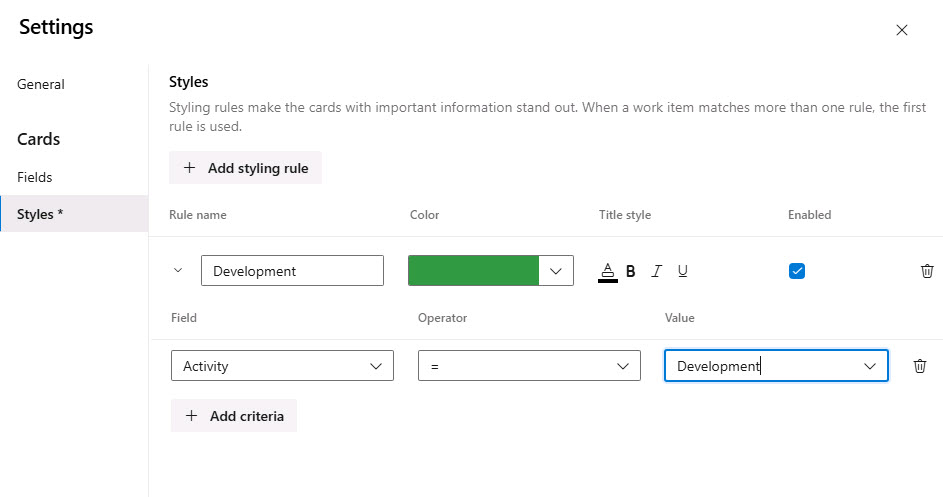Agile planning and portfolio management with Azure Boards
Lab requirements
-
This lab requires Microsoft Edge or an Azure DevOps supported browser.
-
Set up an Azure DevOps organization: If you don’t already have an Azure DevOps organization that you can use for this lab, create one by following the instructions available at Create an organization or project collection.
Lab overview
In this lab, you’ll learn about the agile planning and portfolio management tools and processes provided by Azure Boards and how they can help you quickly plan, manage, and track work across your entire team. You’ll explore the product backlog, sprint backlog, and task boards that can track the flow of work during an iteration. We’ll also look at the enhanced tools in this release to scale for larger teams and organizations.
Objectives
After you complete this lab, you will be able to:
- Manage teams, areas, and iterations.
- Manage work items.
- Manage sprints and capacity.
- Customize Kanban boards.
- Define dashboards.
- Customize team process.
Estimated timing: 60 minutes
Instructions
Exercise 0: (skip if done) Configure the lab prerequisites
In this exercise, you will set up the prerequisites for the lab, which consist of a new Azure DevOps project with a repository based on the eShopOnWeb.
Task 1: (skip if done) Create and configure the team project
In this task, you will create an eShopOnWeb Azure DevOps project to be used by several labs.
- On your lab computer, in a browser window open your Azure DevOps organization. Click on New Project. Give your project the name eShopOnWeb. Define Private as Visibility option.
-
Click Advanced and specify Scrum as Work Item Process. Click on Create.
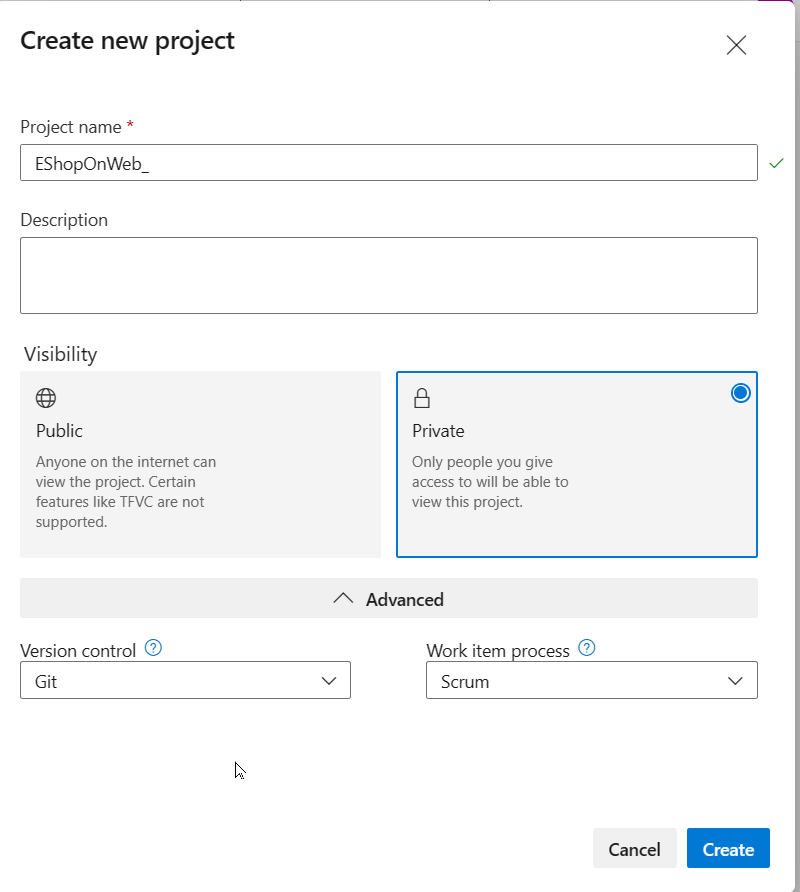
Exercise 1: Manage Agile project
In this exercise, you will use Azure Boards to perform a number of common agile planning and portfolio management tasks, including management of teams, areas, iterations, work items, sprints and capacity, customizing Kanban boards, defining dashboards, and customizing team processes.
Task 1: Manage teams, areas, and iterations
In this task, you will create a new team and configure its area and iterations.
Each new project is configured with a default team, which name matches the project name. You have the option of creating additional teams. Each team can be granted access to a suite of Agile tools and team assets. The ability to create multiple teams gives you the flexibility to choose the proper balance between autonomy and collaboration across the enterprise.
-
On your lab computer, start a web browser and navigate to the Azure DevOps portal at
https://aex.dev.azure.com.Note: If prompted, sign in using the Microsoft account associated with your Azure DevOps subscription.
-
Open the eShopOnWeb project under your Azure DevOps organization.
Note: Alternatively, you can access the project page directly by navigating to the https://dev.azure.com/YOUR-AZURE-DEVOPS-ORGANIZATION/PROJECT-NAME URL, where the YOUR-AZURE-DEVOPS-ORGANIZATION placeholder, represents your account name, and the PROJECT-NAME placeholder represents the name of the project.
-
Click the cogwheel icon labeled Project settings located in the lower left corner of the page to open the Project settings page.

-
In the General section, select the Teams tab. There is already a default team in this project, eShopOnWeb Team but you’ll create a new one for this lab. Click New Team.

-
On the Create a new team pane, in the Team name textbox, type
EShop-Web, leave other settings with their default values, and click Create.
-
In the list of Teams, select the newly created team to view its details.
Note: By default, the new team has only you as its member. You can use this view to manage such functionality as team membership, notifications, and dashboards.
-
Click Iterations and Area Paths link at the top of the EShop-Web page to start defining the schedule and scope of the team.

-
At the top of the Boards pane, select the Iterations tab and then click + Select iteration(s).
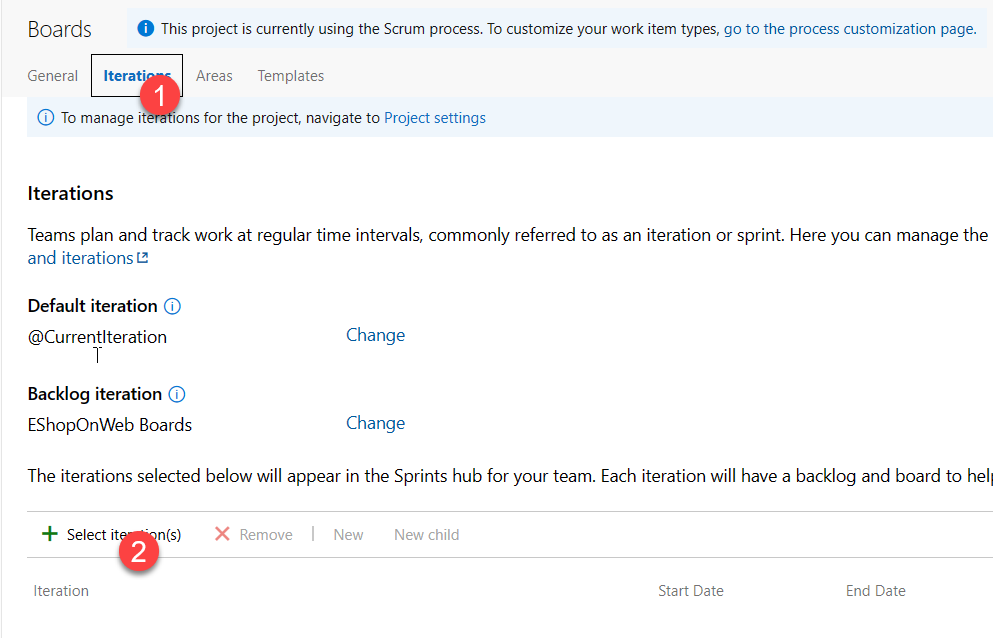
- Select eShopOnWeb\Sprint 1 and click Save and close. Note that this first sprint will show up in the list of iterations, but the Dates are not set yet.
-
Select Sprint 1 and click the ellipsis (…). From the context menu, select Edit.

Note: Specify the Start Date as the first work day of last week, and count 3 full work weeks for each sprint. For example, if March 6 is the first work day of the sprint, it goes until March 24th. Sprint 2 starts on March 27, which is 3 weeks out from March 6.
-
Repeat the previous step to add Sprint 2 and Sprint 3. You could say that we are currently in the 2nd week of the first sprint.

-
Still in the Project Settings / Boards / Team Configuration pane, at the top of the pane, select the Areas tab. You will find there an automatically generated area with the name matching the name of the team.
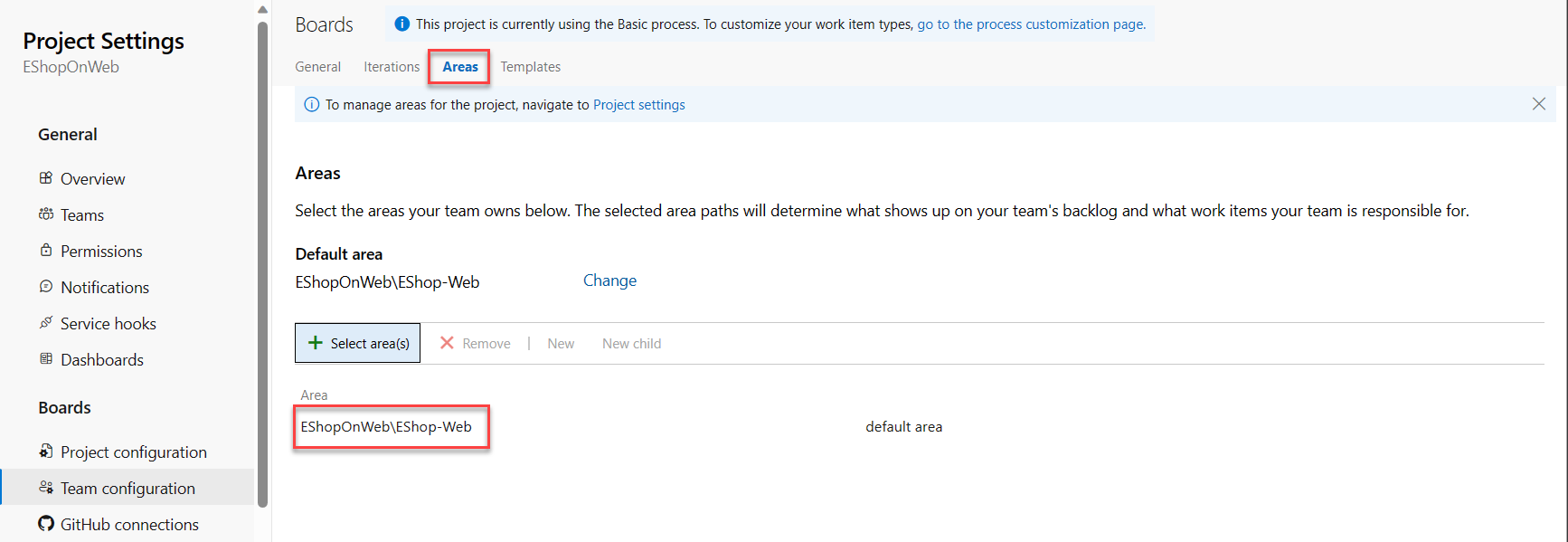
-
Click the ellipsis symbol (…) next to the default area entry and, in the dropdown list, select Include sub areas.
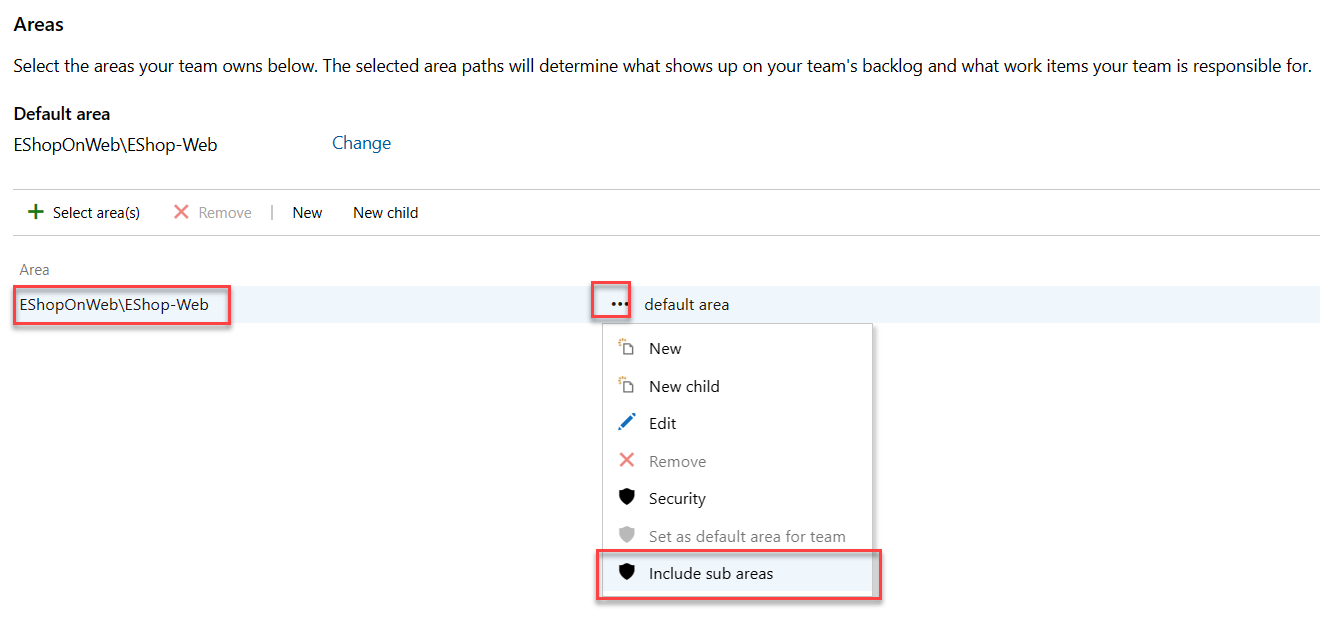
Note: The default setting for all teams is to exclude sub-area paths. We will change it to include sub-areas so that the team gets visibility into all of the work items from all teams. Optionally, the management team could also choose to not include sub-areas, which automatically removes work items from their view as soon as they are assigned to one of the teams.
Task 2: Manage work items
In this task, you will step through common work item management tasks.
Work items play a prominent role in Azure DevOps. Whether describing work to be done, impediments to release, test definitions, or other key items, work items are the workhorse of modern projects. In this task you’ll focus on using various work items to set up the plan to extend the eShopOnWeb site with a product training section. While it can be daunting to build out such a substantial part of a company’s offering, Azure DevOps and the Scrum process make it very manageable.
Note: This task is designed to illustrate a variety of ways you can create different kinds of work items, as well as to demonstrate the breadth of features available on the platform. As a result, these steps should not be viewed as prescriptive guidance for project management. The features are intended to be flexible enough to fit your process needs, so explore and experiment as you go.
-
Click on the project name in the upper left corner of the Azure DevOps portal to return to the project home page.
-
In the vertical navigational pane of the Azure DevOps portal, select the Boards icon and, select Work Items.
Note: There are many ways to create work items in Azure DevOps, and we’ll explore a few of them. Sometimes it’s as simple as firing one off from a dashboard.
-
On the Work Items window, click on + New Work Item > Epic.
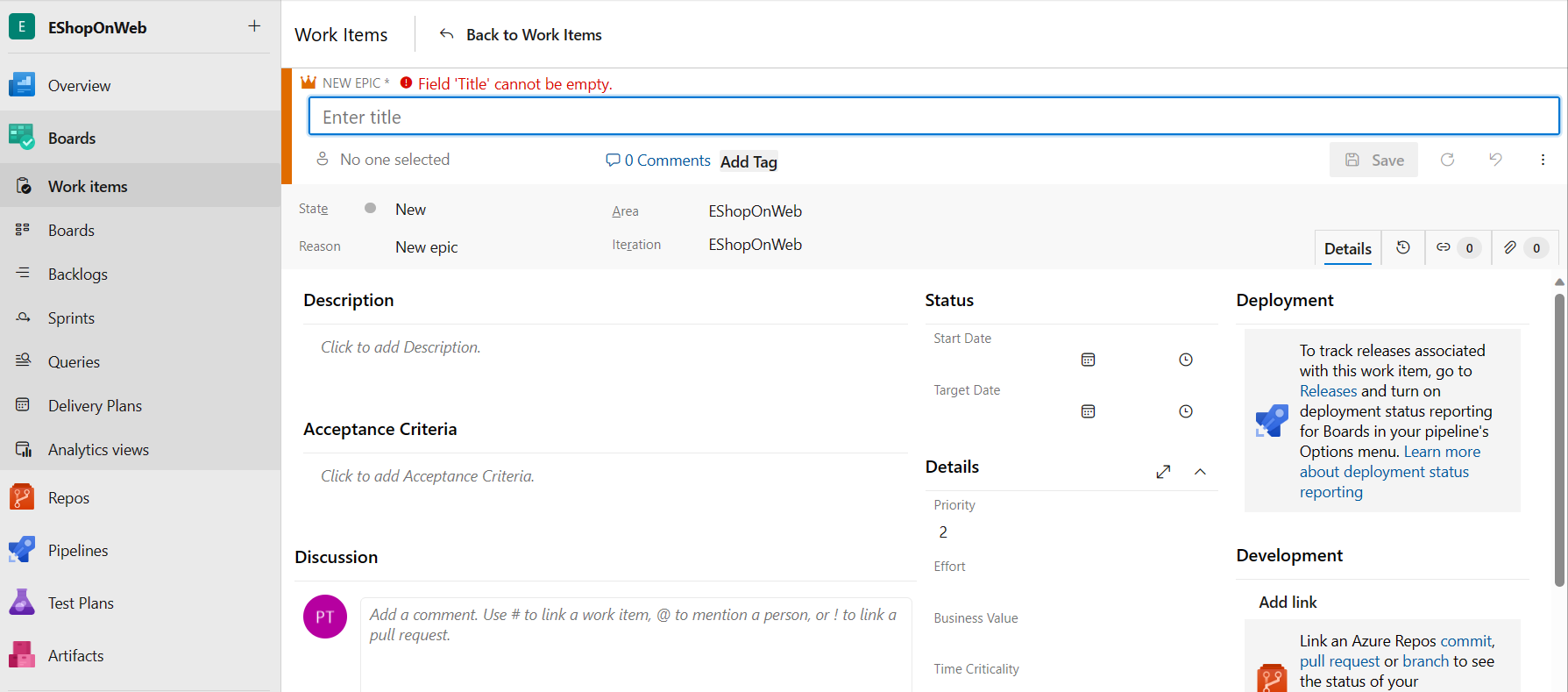
- In the Enter title textbox, type
Product training. - In the upper left corner, select the No one selected entry and, in the dropdown list, select your user account in order to assign the new work item to yourself. If your name doesn’t appear to start with, begin typing your name and click Search.
- Next to the Area entry, select the eShopOnWeb entry and, in the dropdown list, select EShop-WEB. This will set the Area to eShopOnWeb\EShop-WEB.
- Next to the Iteration entry, select the eShopOnWeb entry and, in the dropdown list, select Sprint 2. This will set the Iteration to eShopOnWeb\Sprint 2.
-
Click Save to finalize your changes. Do not close it.

Note: Ordinarily you would want to fill out as much information as possible, but this is sufficient for the purposes of this lab.
Note: The work item form includes all of the relevant work item settings. This includes details about who it’s assigned to, its status across many parameters, and all the associated information and history for how it has been handled since creation. One of the key areas to focus on is the Related Work. We will explore one of the ways to add a feature to this epic.
- In the Related work section on the lower right-side, select the Add link entry and, in the dropdown list, select New item.
-
On the Add link panel, in the Link Type dropdown list, select Child. Next, in the Work item type dropdown list, select Feature, in the Title textbox, type
Training dashboard.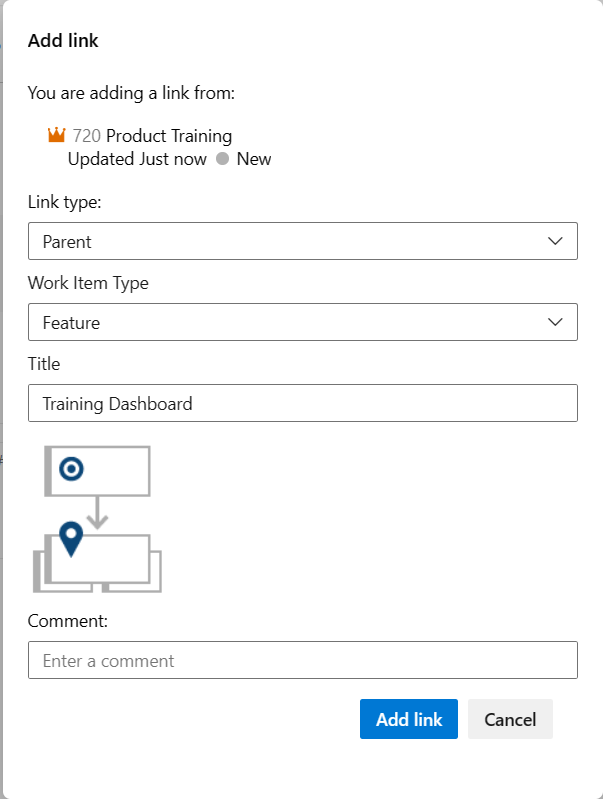
-
Click Add link to save the Child item
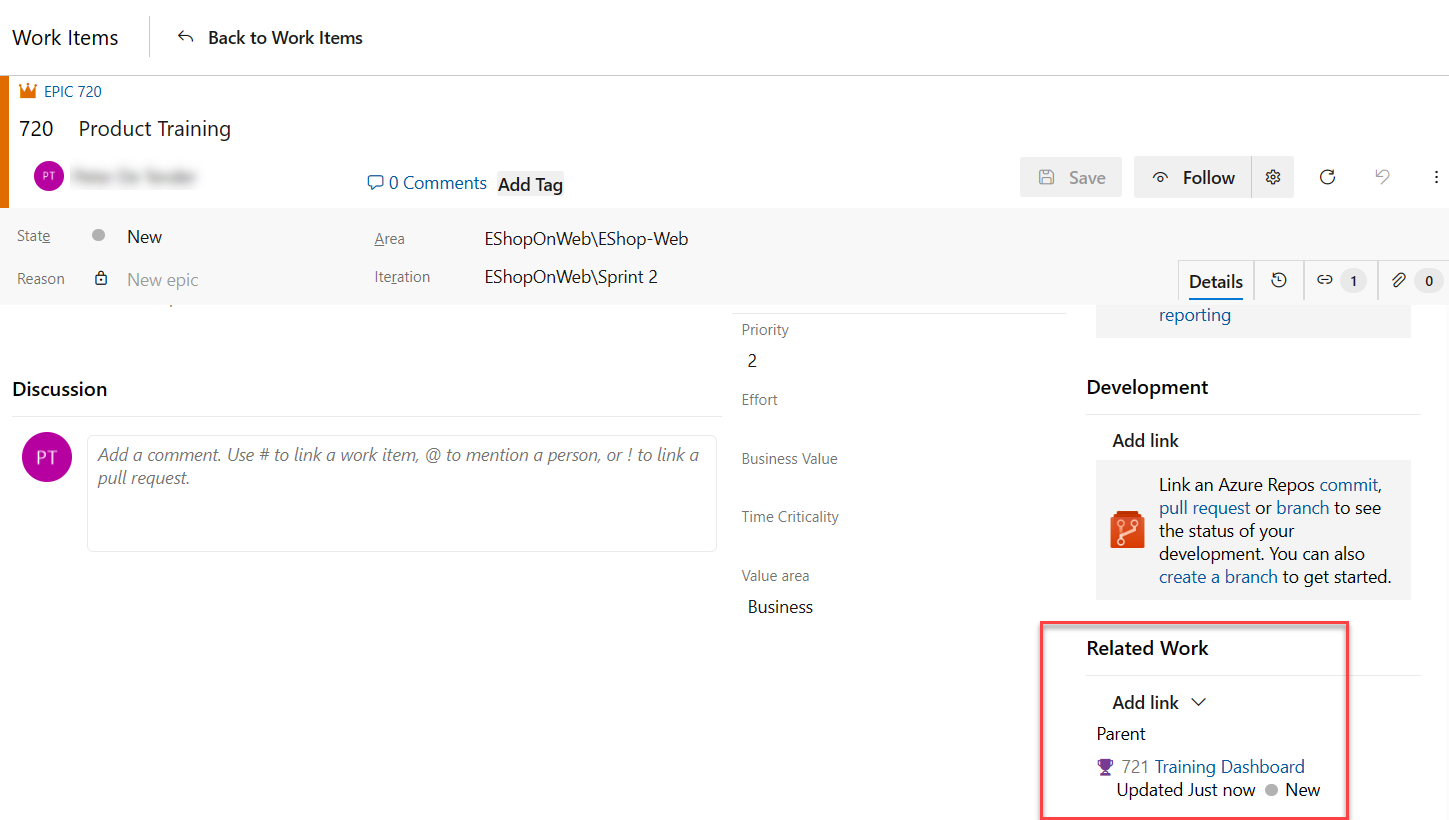
Note: On the Training dashboard panel, note that the assignment, Area, and Iteration are already set to the same values as the epic that the feature is based on. In addition, the feature is automatically linked to the parent item it was created from.
-
On the (New Feature) Training dashboard panel, click Save and Close.
- In the vertical navigation pane of the Azure DevOps portal, in the list of the Boards items, select Boards.
-
On the Boards panel, select the EShop-WEB boards entry. This will open the board for that particular team.
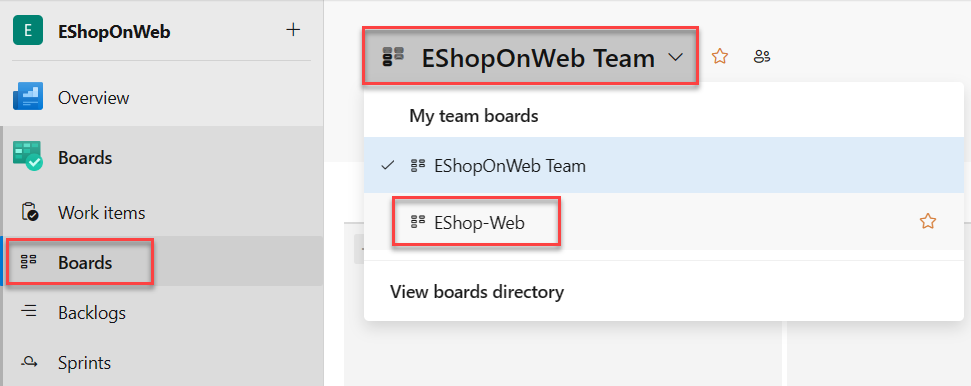
-
On the Boards panel, in the upper right corner, select the Backlog items entry and, in the dropdown list, select Features.
Note: This will make it easy to add tasks and other work items to the features.
- Hover with the mouse pointer over the rectangle representing the Training dashboard feature. This will reveal the ellipsis symbol (…) in its upper right corner.
-
Click the ellipsis (…) icon and, in the dropdown list, select Add Product Backlog Item.
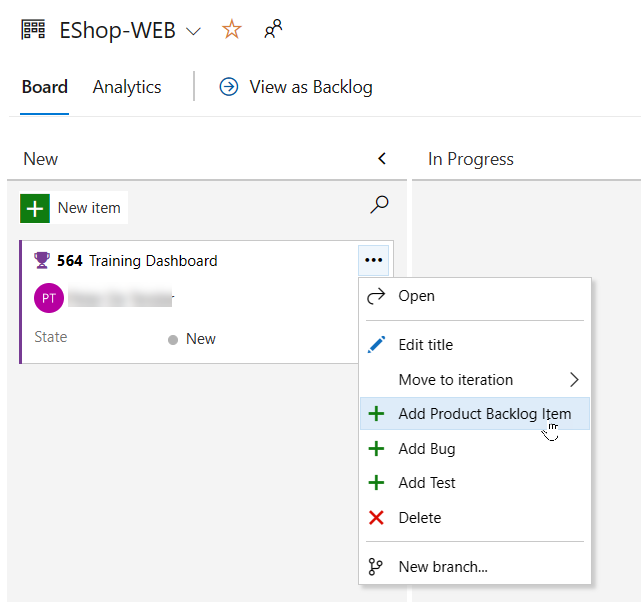
-
In the textbox of the new product backlog item, type
As a customer, I want to view new tutorialsand press the Enter key to save the entry.Note: This creates a new product backlog item (PBI) work item that is a child of the feature and shares its area and iteration.
-
Repeat the previous step to add two more PBIs designed to enable the customer to see their recently viewed tutorials and to request new tutorials named, respectively,
As a customer, I want to see tutorials I recently viewedandAs a customer, I want to request new tutorials.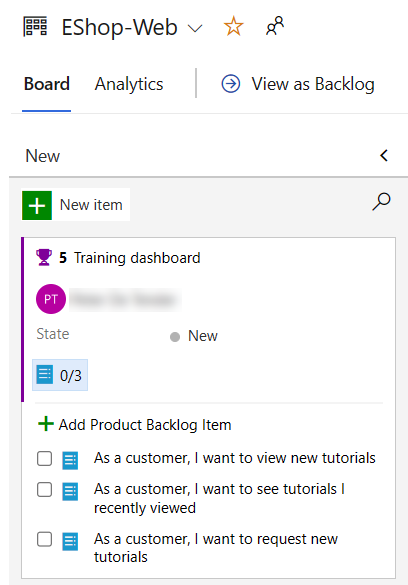
-
On the Boards panel, in the upper right corner, select the Features entry and, in the dropdown list, select Backlog items.
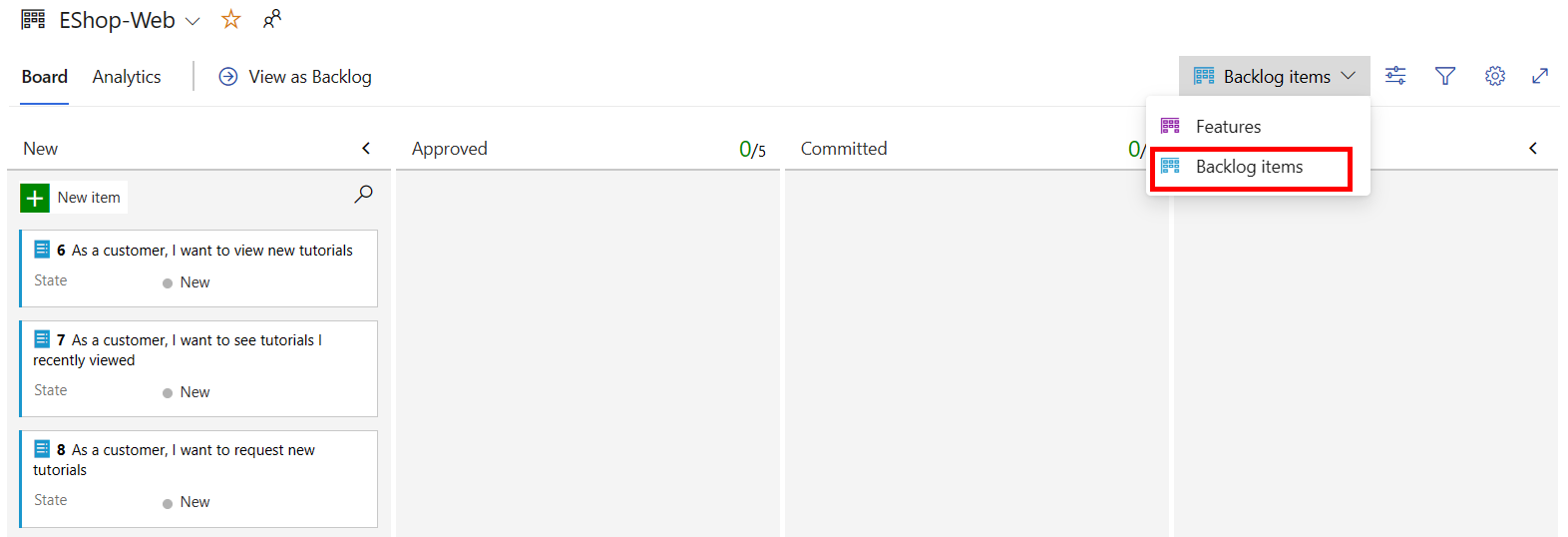
Note: Backlog items have a state that defines where they are relative to being completed. While you could open and edit the work item using the form, it’s easier to just drag cards on the board.
-
On the Board tab of the EShop-WEB panel, drag the first work item named As a customer, I want to view new tutorials from the New to Approved stage.
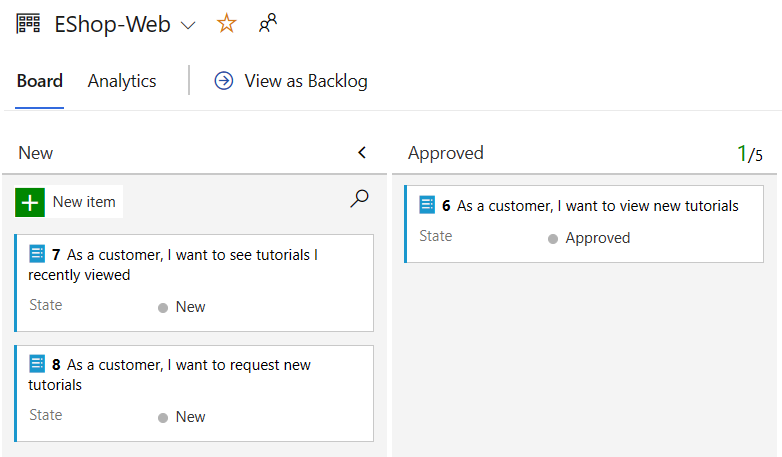
Note: You can also expand work item cards to get to conveniently editable details.
- Hover with the mouse pointer over the rectangle representing the work item you moved to the Approved stage. This will reveal the down facing caret symbol.
- Click the down facing caret symbol to expand the work item card, replace the Unassigned entry with your name, then select your account to assign the moved PBI to yourself.
- On the Board tab of the EShop-WEB panel, drag the second work item named As a customer, I want to see tutorials I recently viewed from the New to the Committed stage.
-
On the Board tab of the EShop-WEB panel, drag the third work item named As a customer, I want to request new tutorials from the New to the Done stage.

Note: The task board is one view into the backlog. You can also use the tabular view.
-
On the Board tab of the EShop-WEB pane, at the top of the pane, click View as Backlog to display the tabular form.
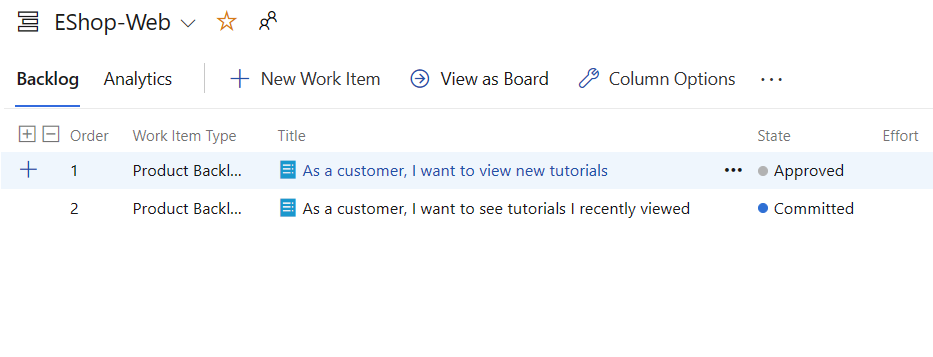
Note: You can use the plus sign directly under the Backlog tab label of the EShop-WEB panel to view nested tasks under these work items.
Note: You can use the second plus sign directly left to the first backlog item to add a new task to it.
-
On the Backlog tab of the EShop-WEB pane, in the upper left corner of the pane, click the plus sign next to the first work item. This will display the NEW TASK panel.

- At the top of the NEW TASK panel, in the Enter title textbox, type
Add page for most recent tutorials. - On the NEW TASK panel, in the Remaining Work textbox, type 5.
- On the NEW TASK panel, in the Activity dropdown list, select Development.
-
On the NEW TASK panel, click Save and Close.
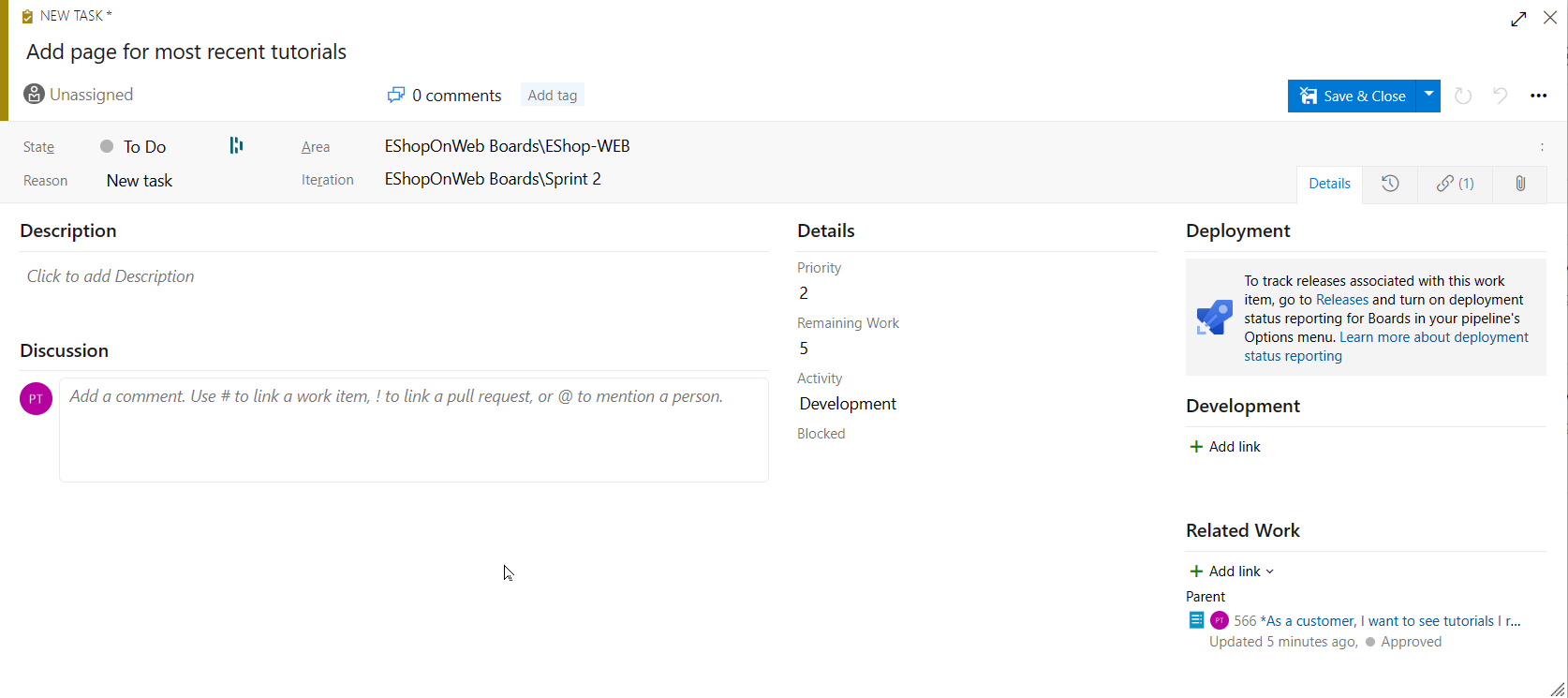
- Repeat the last five steps to add another task named
Optimize data query for most recent tutorials. Set its Remaining Work to 3 and its Activity to Design. Click Save and Close once completed.
Task 3: Manage sprints and capacity
In this task, you will step through common sprint and capacity management tasks.
Teams build the sprint backlog during the sprint planning meeting, typically held on the first day of the sprint. Each sprint corresponds to a time-boxed interval which supports the team’s ability to work using Agile processes and tools. During the planning meeting, the product owner works with the team to identify those stories or backlog items to complete in the sprint.
Planning meetings typically consist of two parts. In the first part, the team and product owner identify the backlog items that the team feels it can commit to completing in the sprint, based on experience with previous sprints. These items get added to the sprint backlog. In the second part, the team determines how it will develop and test each item. They then define and estimate the tasks required to complete each item. Finally, the team commits to implementing some or all the items based on these estimates.
The sprint backlog should contain all the information the team needs to successfully plan and complete work within the time allotted without having to rush at the end. Before planning the sprint, you’d want to have created, prioritized, and estimated the backlog and defined the sprints.
- In the vertical navigational pane of the Azure DevOps portal, select the Boards icon and, in the list of the Boards items, select Sprints.
-
On the Taskboard tab of the Sprints view, in the toolbar, on the right hand side, select the View options symbol (directly to the left of the funnel icon) and, in the View options dropdown list, select the Work details entry. Select Sprint 2 as filter.
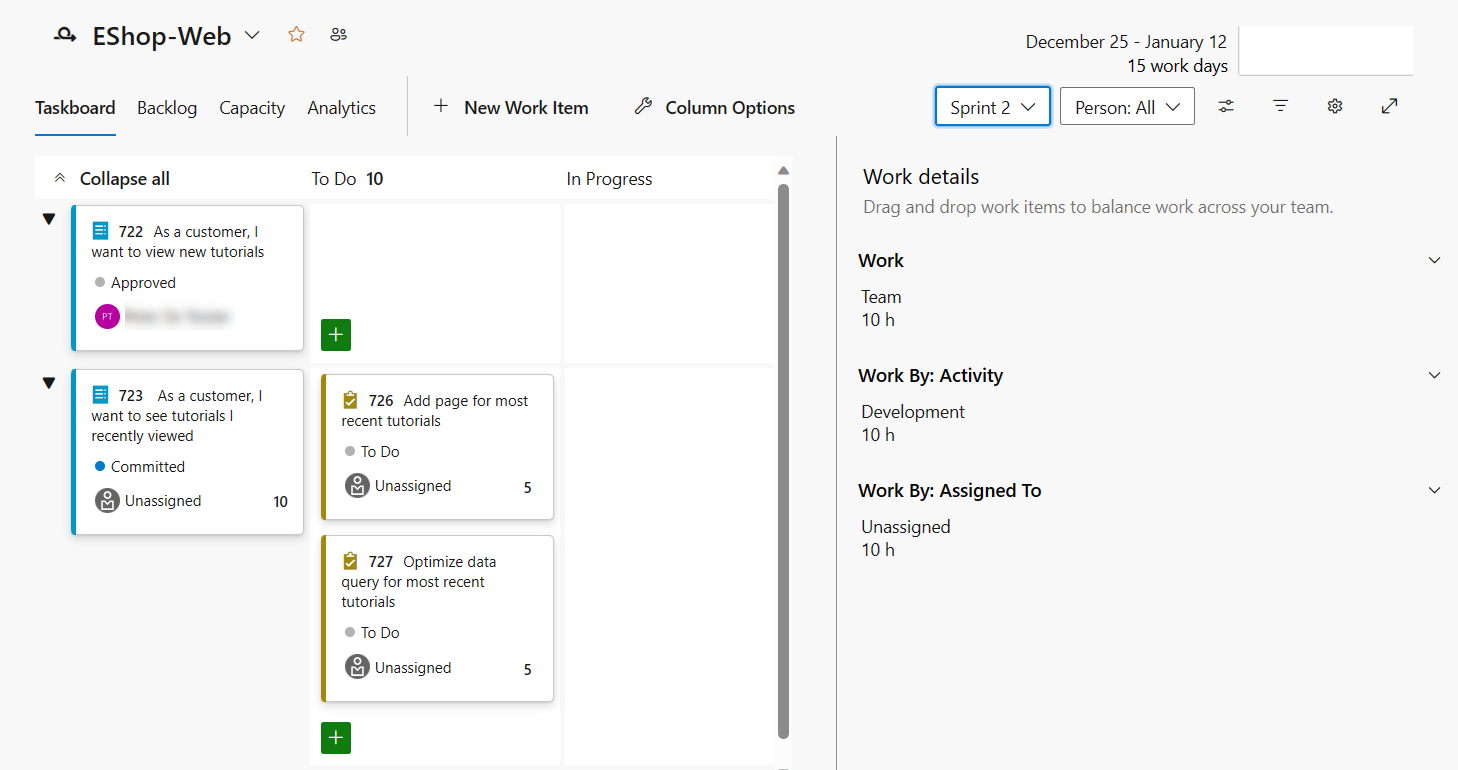
Note: The current sprint has a pretty limited scope. There are two tasks in the To do stage. At this point, neither task has been assigned. Both show a numeric value to the right of Unassigned entry representing the remaining work estimate.
-
Within the ToDo Column, notice the Task Item Add page for most recent tutorials, click the Unassigned entry and, in the list of user accounts, select your account to assign the task to yourself.
-
Select the Capacity tab of the Sprints view.
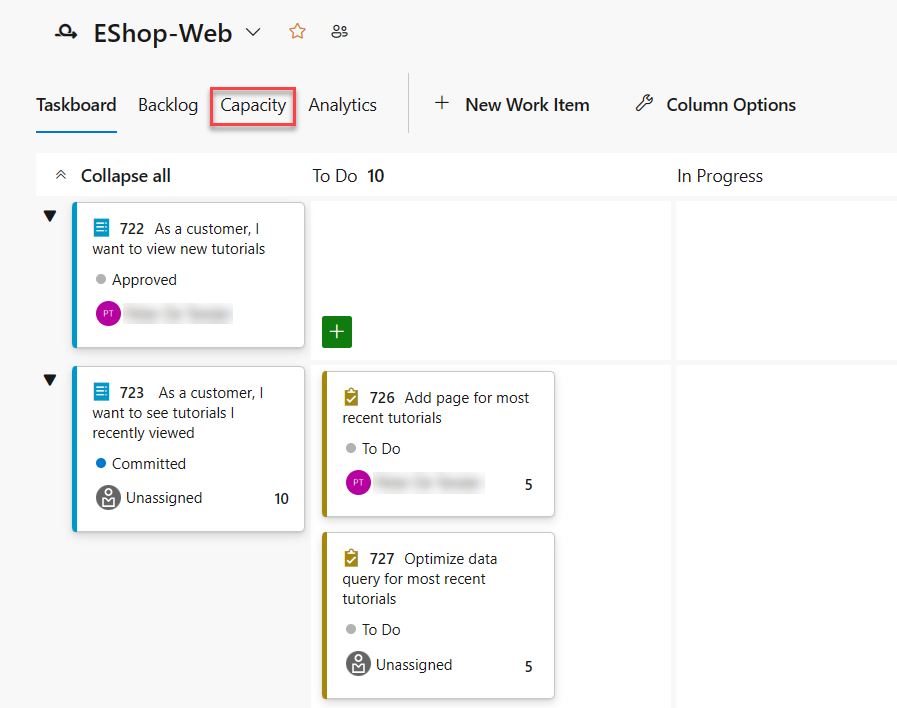
Note: This view enables you to define what activities a user can take on and at what level of capacity.
-
On the Capacity tab of the Sprints view, for your user account, set the Activity field to Development and, in the Capacity per day textbox, type 1. Then click Save.
Note: This represents 1 hour of development work per day. Note that you can add additional activities per user in the case they do more than just development.
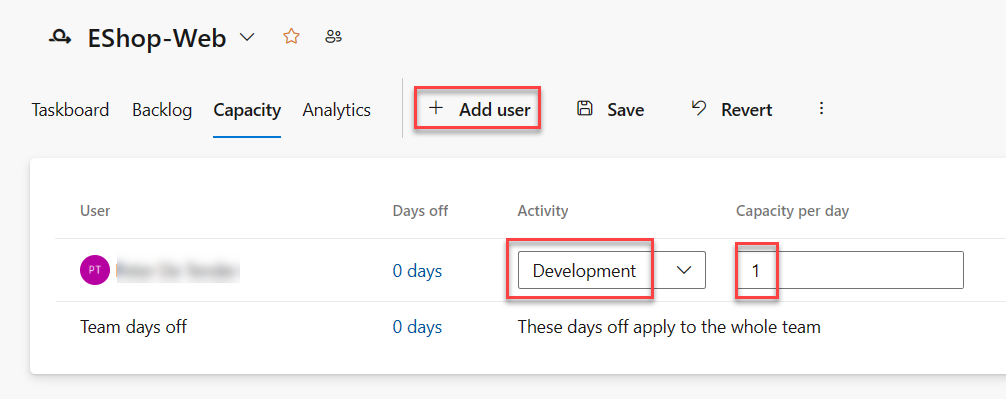
Note: Let’s assume you’re also going to take some vacation. Which should be added to the capacity view too.
- On the Capacity tab of the Sprints view, directly next to the entry representing your user account, in the Days off column, click the 0 days entry. This will display a panel where you can set your days off.
-
In the displayed panel, use the calendar view to set your vacation to span five work days during the current sprint (within the next three weeks) and, once completed, click OK.
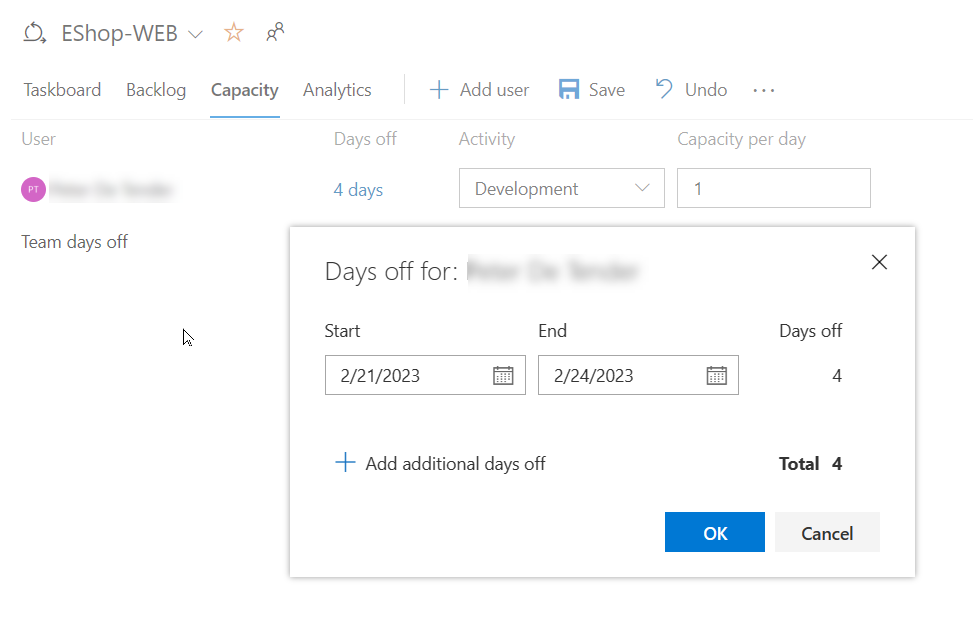
- Back on the Capacity tab of the Sprints view, click Save.
-
Select the Taskboard tab of the Sprints view.
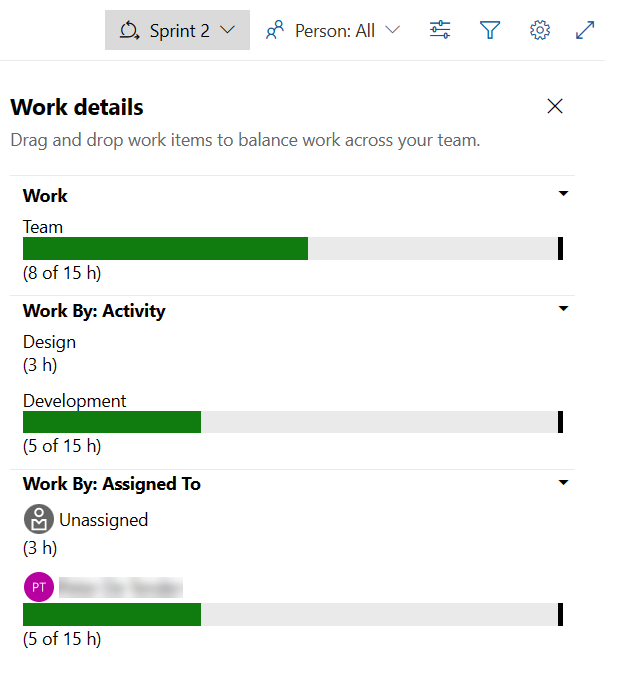
Note: Note that the Work details panel has been updated to reflect your available bandwidth. The actual number displayed in the Work details panel might vary, but your total sprint capacity will be equal to the number of working days remaining till the end of the sprint, since you allocated 1 hour per day. Take a note of this value since you will use it in the upcoming steps.
Note: One convenient feature of the boards is that you can easily update key data in-line. It’s a good practice to regularly update the Remaining Work estimate to reflect the amount of time expected for each task. Let’s say you’ve reviewed the work for the Add page for most recent tutorials task and found that it will actually take longer than originally expected.
-
On the Taskboard tab of the Sprints view, in the square box representing the Add page for most recent tutorials, set the estimated number of hours to 14, to match your total capacity for this sprint, which you identified in the previous step.
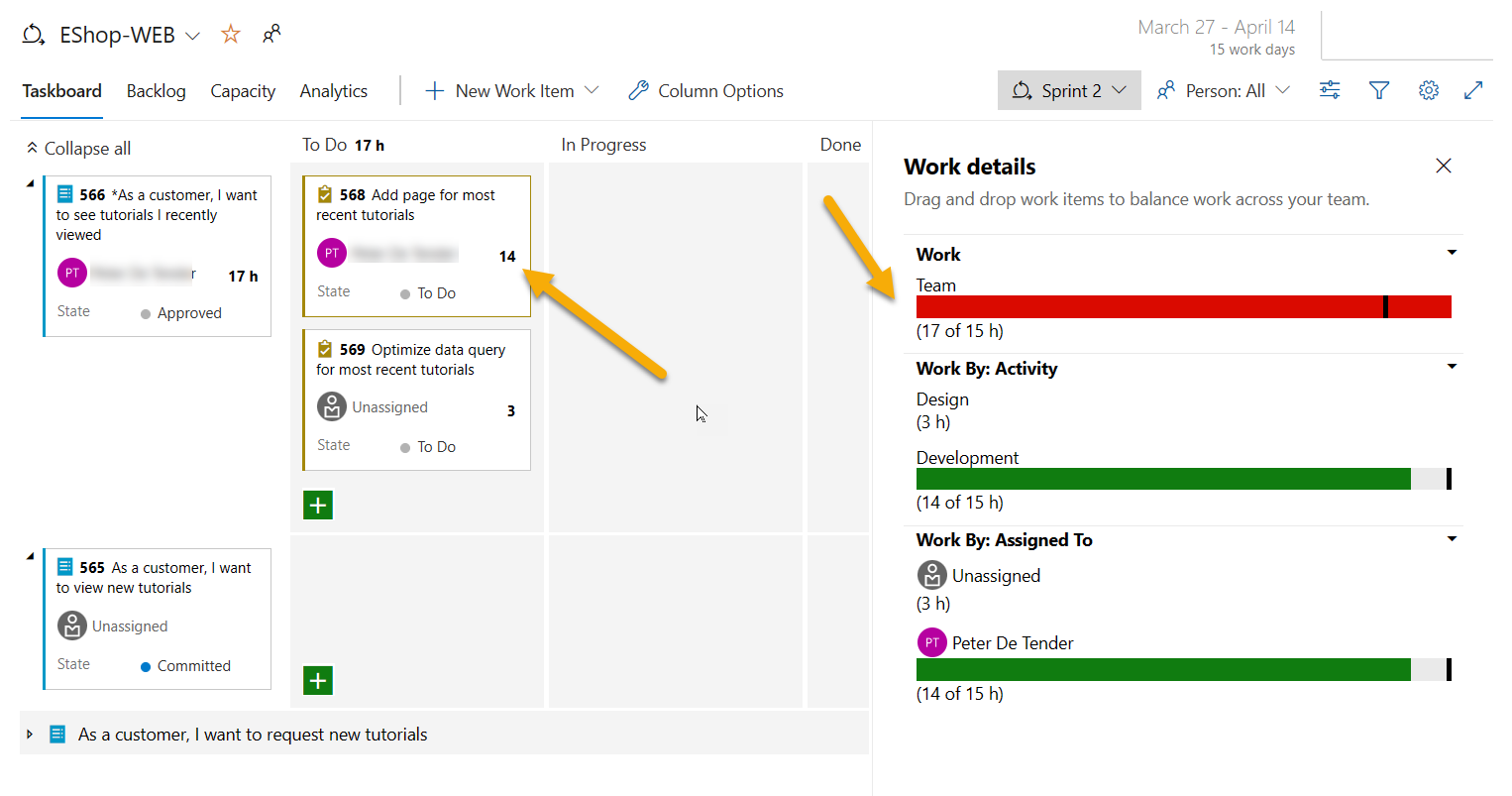
Note: This automatically expands the Development and your personal capacities to their maximum. Since they’re large enough to cover the assigned tasks, they stay green. However, the overall Team capacity is exceeded due to the additional 3 hours required by the Optimize data query for most recent tutorials task.
Note: One way to resolve this capacity issue would be to move the task to a future iteration. There are a few ways this could be done. You could, for example, open the task here and edit it within the panel providing access to the task details. Another approach would be to use the Backlog view, which provides an in-line menu option to move it. At this point though, don’t move the task yet.
-
On the Taskboard tab of the Sprints view, in the toolbar, on the right hand side, select the View options symbol (directly to the left of the funnel icon) and, in the View options dropdown list, select the Assigned To entry.
Note: This adjusts your view such that you can review the progress of tasks by person instead of by backlog item.
Note: There is also a lot of customization available.
- Click the Configure team settings cogwheel icon (directly to the right of the funnel icon).
-
On the Settings panel, select the Styles tab, click + Add styling rule, under the Rule name label, in the Name textbox, type
Development, and, in the Color dropdown list, select the green rectangle.Note: This will color all cards green if they meet the rule criteria set directly below the rule name.
-
In the section under the rule name, in the Field dropdown list, select Activity, in the Operator dropdown list, select =, and, in the Value dropdown list, select Development.
-
Click Save to save and close the settings.
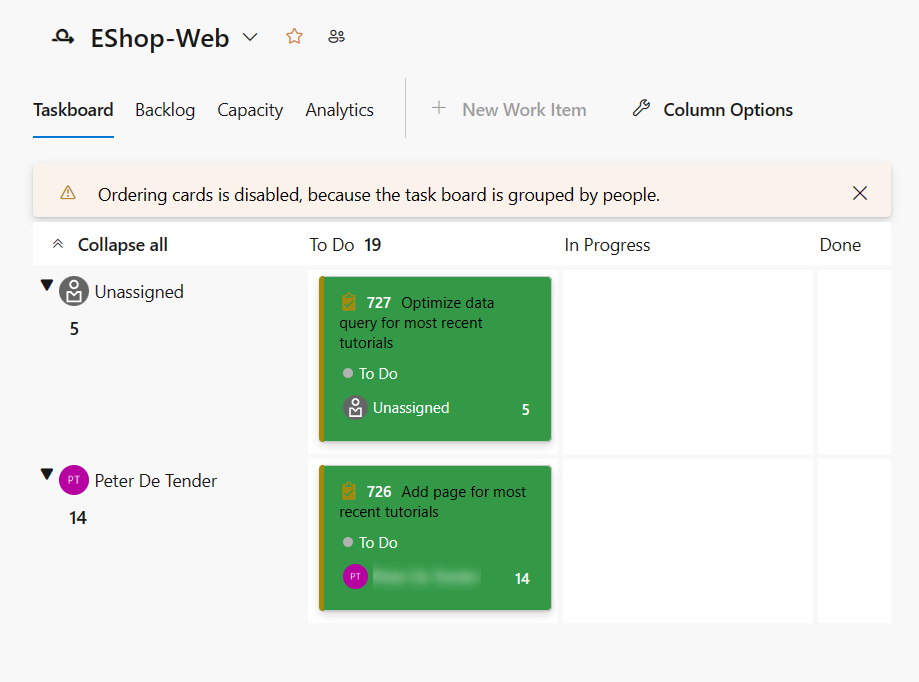
Note: This will set all cards assigned to Development activities green.
-
Go back to the Settings panel, select the General tab, and under the Backlogs section, view and configure the navigation levels.
Note: Epics are not included by default, but you could change that.
-
In the Settings panel, select the General tab, and under the Working days section specify the working days the team follows.
Note: This applies to capacity and burndown calculations.
-
In the Settings panel, select the General tab, and under the Working with bugs section you can specify how you manage bugs in backlogs and boards.
Note: Entries on this tab allow you to specify how bugs are presented on the board.
-
On the Settings panel, click Save to save and close the styling rule.
Note: The task associated with Development is now green and very easy to identify.
Task 4: Customize Kanban boards
In this task, you will step through the process of customizing Kanban boards.
To maximize a team’s ability to consistently deliver high quality software, Kanban emphasizes two main practices. The first, visualizing the flow of work, requires that you map your team’s workflow stages and configure a Kanban board to match. The second, constraining the amount of work in progress, requires that you set work-in-progress (WIP) limits. You’re then ready to track progress on your Kanban board and monitor key metrics to reduce lead or cycle time. Your Kanban board turns your backlog into an interactive signboard, providing a visual flow of work. As work progresses from idea to completion, you update the items on the board. Each column represents a work stage, and each card represents a user story (blue cards) or a bug (red cards) at that stage of work. However, every team develops its own process over time, so the ability to customize the Kanban board to match the way your team works is critical for the successful delivery.
- In the vertical navigational pane of the Azure DevOps portal, in the list of the Boards items, select Boards.
-
On the Boards panel, click the Configure board settings cogwheel icon (directly to the right of the funnel icon).
Note: The team is emphasizing work done with data, so there is special attention paid to any task associated with accessing or storing data.
-
On the Settings panel, select the Tag colors tab, click + Add tag color, in the Tag textbox, type
dataand select the yellow rectangle.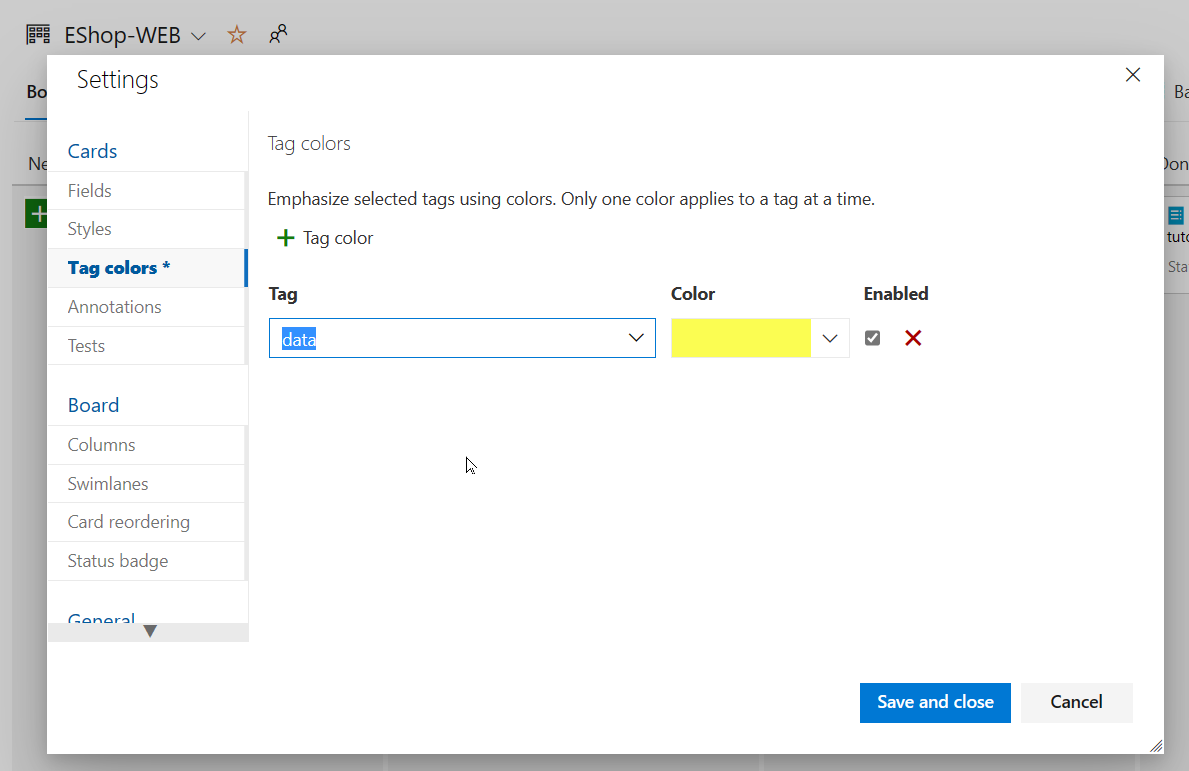
Note: Whenever a backlog item or bug is tagged with data, that tag will be highlighted.
-
Select the Annotations tab.
Note: You can specify which Annotations you would like included on cards to make them easier to read and navigate. When an annotation is enabled, the child work items of that type are easily accessible by clicking the visualization on each card.
-
Select the Tests tab.
Note: The Tests tab enables you to configure how tests appear and behave on the cards.
- Click Save to save and close the settings.
- From the Board tab of the EShop-WEB panel, open the Work Item representing the As a customer, I want to view new tutorials backlog item.
- From the detailed item view, at the top of the panel, to the right of the 0 comments entry, click Add tag.
- In the resulting textbox, type
dataand press the Enter key. - Repeat the previous step to add the
uxtag. -
Save these edits by clicking Save and Close.
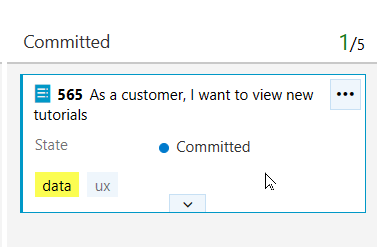
Note: The two tags are now visible on the card, with the data tag highlighted in yellow as configured.
- On the Boards panel, click the Configure board settings cogwheel icon (directly to the right of the funnel icon).
-
On the Settings panel, select the Columns tab.
Note: This section allows you to add new stages to the workflow.
-
Click + Add column, under the Column name label, in the Name textbox, type
QA Approvedand, in the WIP limit textbox, type 1Note: The Work in progress limit of 1 indicates that only one work item should be in this stage at a time. You would ordinarily set this higher, but there are only two work items to demonstrate the feature.
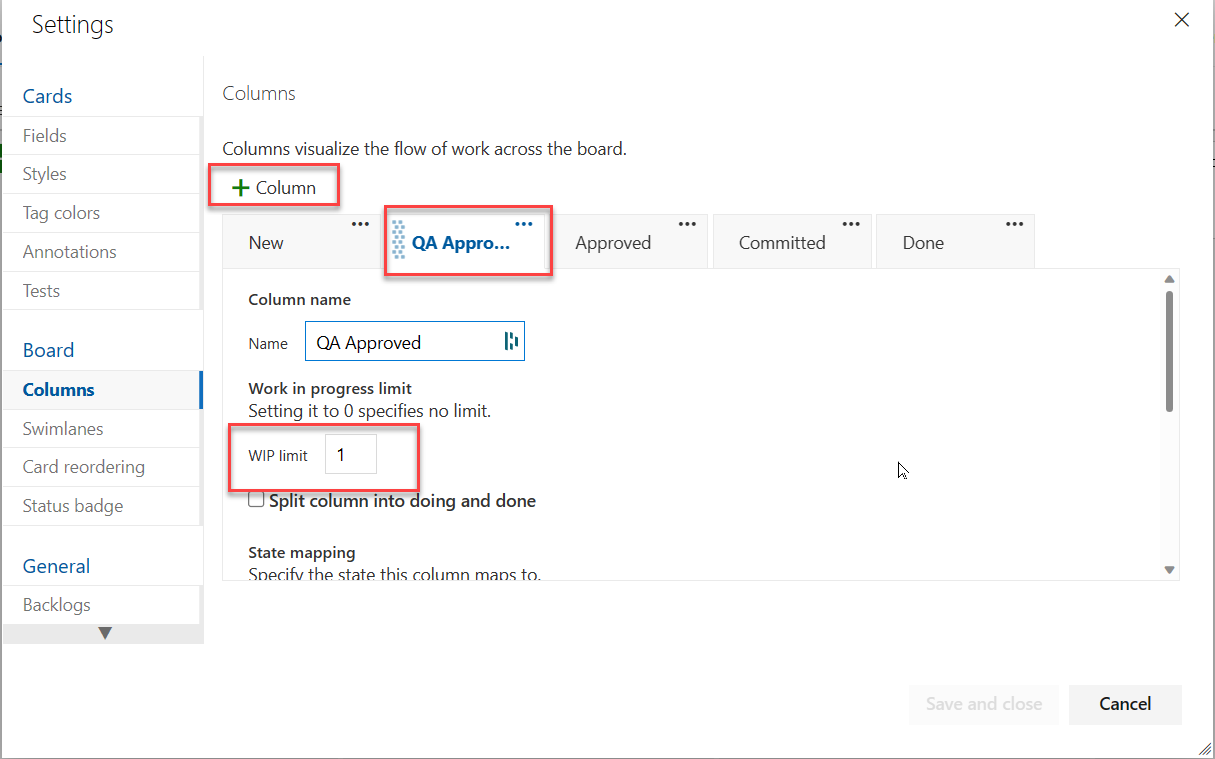
- Notice the ellipsis next to the QA Approved column you created. Select Move right twice, so that the QA Approved column gets positioned in-between Committed and Done.
-
Click Save to save and close the settings.
- On the Boards portal, the QA Approved column is now visible in the Kanban board view.
- Drag the As a customer, I want to see tutorials I recently viewed work item from the Committed stage into the QA Approved stage.
-
Drag the As a customer, I want to view new tutorials work item from the Approved stage into the QA Approved stage.
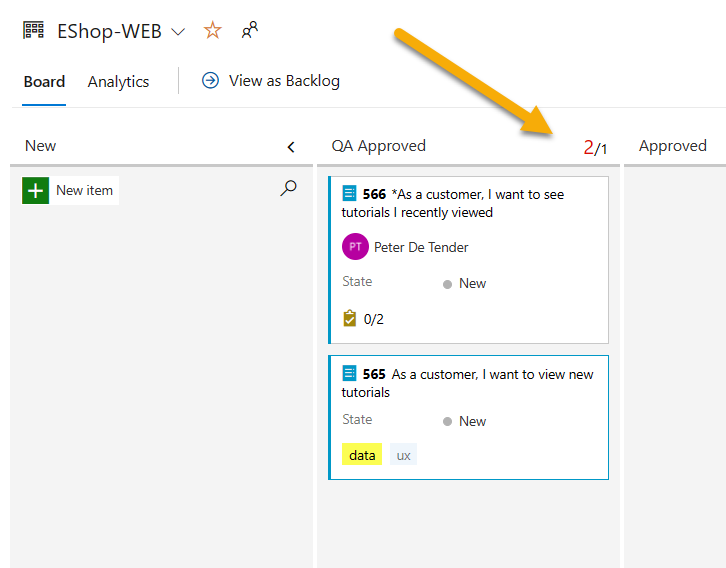
Note: The stage now exceeds its WIP limit and is colored red as a warning.
- Move the As a customer, I want to see tutorials I recently viewed backlog item back to Committed.
- On the Boards panel, click the Configure board settings cogwheel icon (directly to the right of the funnel icon).
-
On the Settings panel, return to the Columns tab and select the QA Approved tab.
Note: A lag often exists between when work gets moved into a column and when work starts. To counter that lag and reveal the actual state of work in progress, you can turn on split columns. When split, each column contains two sub-columns: Doing and Done. Split columns let your team implement a pull model. Without split columns, teams push work forward, to signal that they’ve completed their stage of work. However, pushing it to the next stage doesn’t necessarily mean that a team member immediately starts work on that item.
-
On the QA Approved tab, enable the Split column into doing and done checkbox to create two separate columns.
Note: As your team updates the status of work as it progresses from one stage to the next, it helps that they agree on what done means. By specifying the Definition of done criteria for each Kanban column, you help share the essential tasks to complete before moving an item into a downstream stage.
- On the QA Approved tab, at the bottom of the panel, in the Definition of done textbox, type
Passes **all** tests. -
Click Save to save and close the settings.

Note: The QA Approved stage now has Doing and Done columns. You can also click the informational symbol (with letter i in a circle) next to the column header to read the Definition of done. You may need to refresh the browser to see changes.
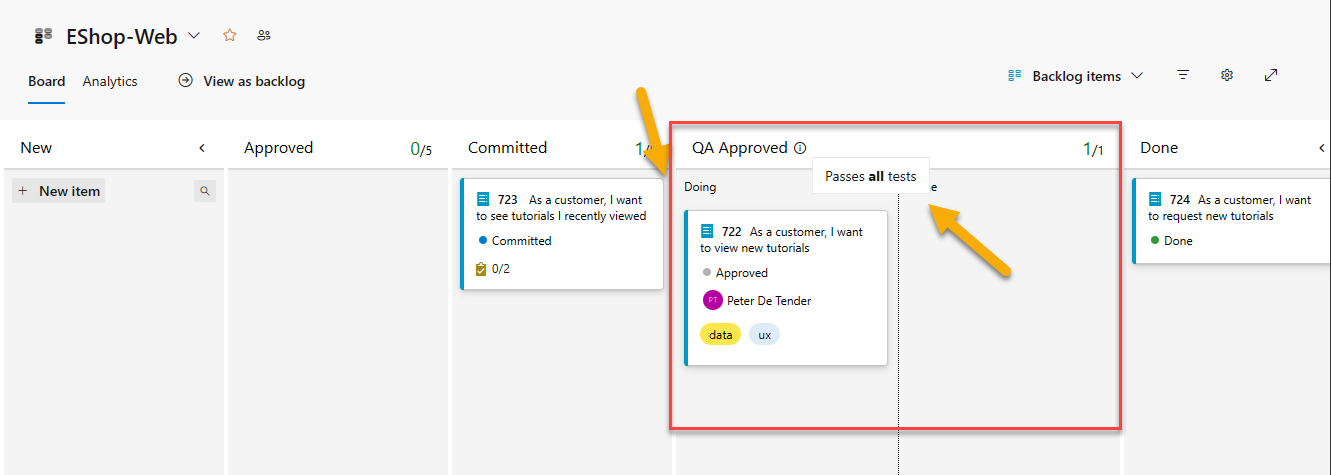
-
On the Boards panel, click the Configure boards settings cogwheel icon (directly to the right of the funnel icon).
Note: Your Kanban board supports your ability to visualize the flow of work as it moves from new to done. When you add swimlanes, you can also visualize the status of work that supports different service-level classes. You can create a swimlane to represent any other dimension that supports your tracking needs.
- On the Settings panel, select the Swimlanes tab.
- On the Swimlanes tab, click + Add swimlane, directly under the Swimlane name label, in the Name textbox, type
Expedite. - In the Color dropdown list, select the Green rectangle.
-
Click Save to save and close the settings.

-
Back on the Board tab of the Boards panel, drag and drop the Committed work item onto the QA Approved | Doing stage of the Expedite swimlane so that it gets recognized as having priority when QA bandwidth becomes available.
Note: You may need to refresh the browser to make the swimlane visible.
In this exercise you learned how to use the Kanban board to visualize the flow of work in a way that is easy to understand and to track progress. You also learned how to configure the board to support your team’s process and how to set the work in progress (WIP) limit to ensure that the team doesn’t get overwhelmed with work.
Exercise 2: Define dashboards
Task 1: Create and customize dashboards
In this task, you will step through the process of creating dashboards and their core components.
Dashboards allow teams to visualize status and monitor progress across the project. At a glance, you can make informed decisions without having to drill down into other parts of your team project site. The Overview page provides access to a default team dashboard which you can customize by adding, removing, or rearranging the tiles. Each tile corresponds to a widget that provides access to one or more features or functions.
- In the vertical navigational pane of the Azure DevOps portal, select the Overview icon and, in the list of the Overview items, select Dashboards.
-
Select the Overview for the eShopOnWeb Team and review the existing dashboard.
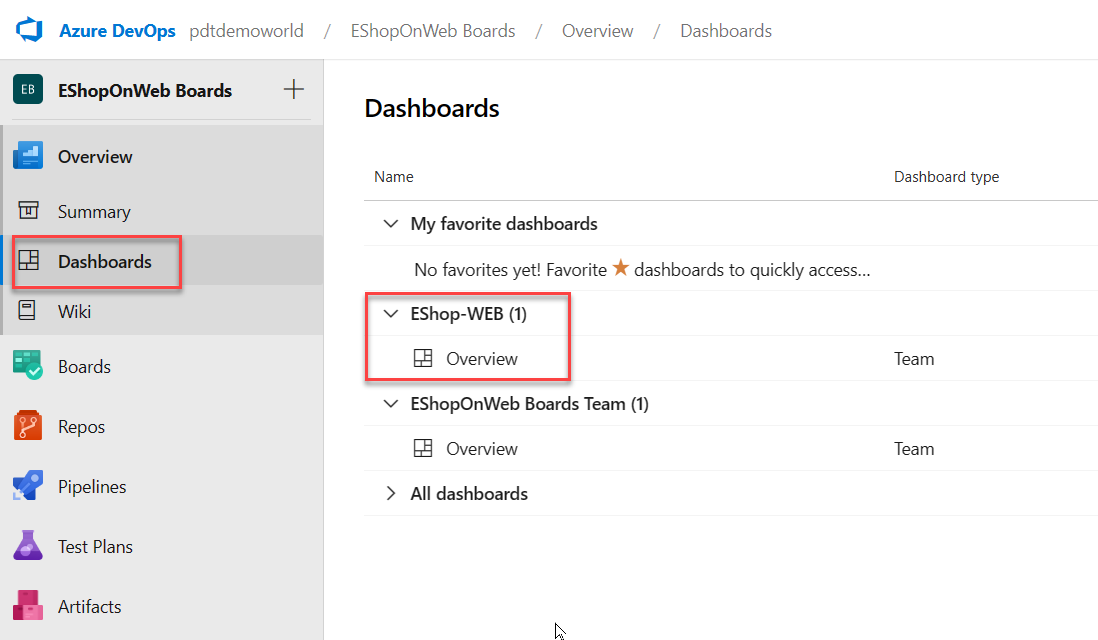
-
On the Dashboards pane, in the upper-right corner, select + New Dashboard.
-
On the Create a dashboard pane, in the Name textbox, type
Product training, in the Team dropdown list, select the EShop-WEB team, and click Create.
- On the new dashboard pane, click Add a widget.
- On the Add Widget panel, in the Search widgets textbox, type
sprintto find existing widgets that focus on sprints. In the list of results, select Sprint Overview and click Add. -
In the rectangle representing the newly added widget, click the Settings cogwheel icon and review the Configuration pane.
Note: The customization level will vary by widget.
- On the Configuration pane, click Close without making any changes.
-
Back on the Add Widget pane, in the Search textbox, type
sprintagain to find existing widgets that focus on sprints. In the list of results, select Sprint Capacity and click Add.Note: If the widget shows “Set capacity to use the sprint capacity widget”, you can select the Set capacity link to set the capacity. Set the Activity to Development and the Capacity to 1. Click Save and back to the dashboard.
-
In the Dashboard view, at the top of the pane, click Done Editing.

Note: You can now review two important aspects of your current sprint on your custom dashboard.
Note: Another way of customizing dashboards is to generate charts based on work item queries, which you can share to a dashboard.
- In the vertical navigational pane of the Azure DevOps portal, select the Boards icon and, in the list of the Boards items, select Queries.
- On the Queries pane, click + New query.
- On the Editor tab of Queries > My Queries pane, in the Value dropdown list of the Work Item Type row, select Task.
- Click on Add new clause, and in the Field column, select Area Path and, in the corresponding Value dropdown list, select eShopOnWeb\EShop-WEB.
-
Click Save.

- In the Enter name textbox, type
Web tasks, in the Folder dropdown list, select Shared Queries, and click OK. - On the Queries > Shared Queries pane, click Web tasks to open the query.
- Select the Charts tab and click New chart.
-
On the Configure Chart panel, in the Name textbox, type
Web tasks - By assignment, in the Group by dropdown list, select Assigned To, and click Save chart to save the changes.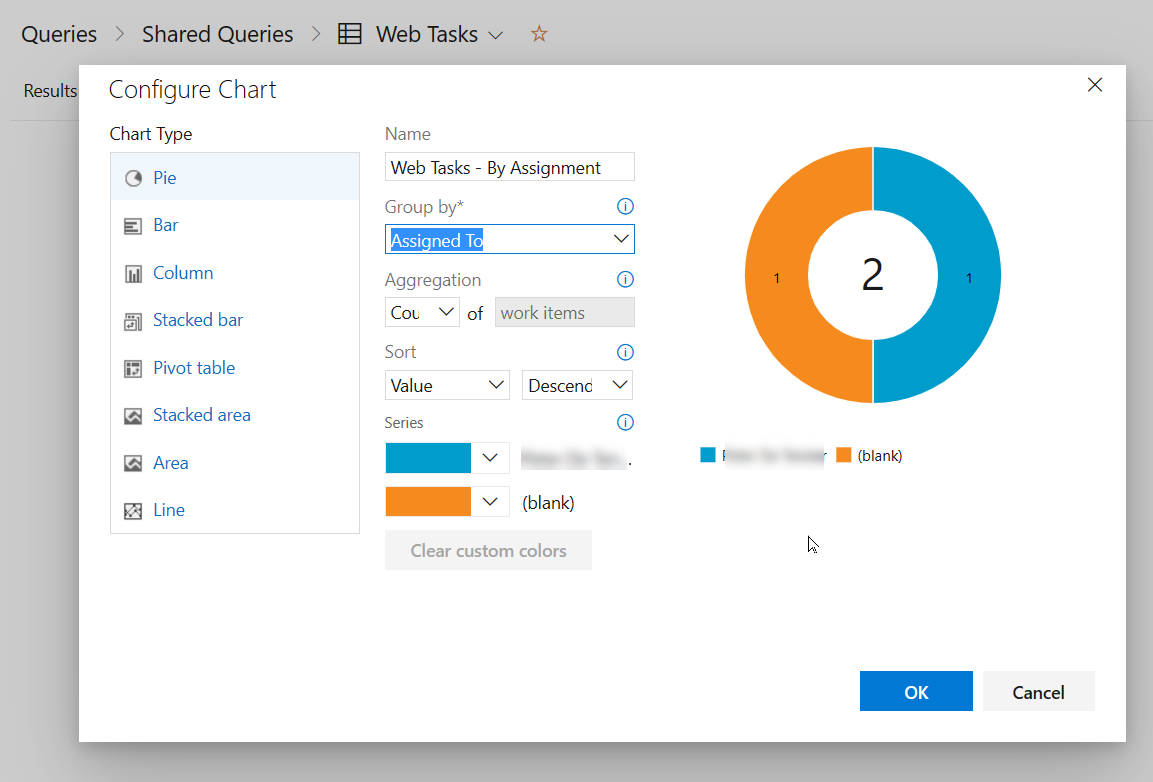
Note: You can now add this chart to a dashboard.
-
Return to the Dashboards section in the Overview Menu. From the EShop-Web section, select the Product Training dashboard you used earlier, to open it.
-
Click Edit from the top menu. From the Add Widget list, search for
Chart, and select Chart for Work Items. Click Add to add this widget to the EShop-Web dashboard. -
Click the configure (cogwheel) within the Chart for Work Items to open the widget settings.
-
Accept the title as is. Under Query, select Shared Queries / Web Tasks. Keep Pie for Chart Type. Under Group By, select Assigned To. Keep the Aggregation (Count) and Sort (Value / Ascending) defaults.
-
Confirm the configuration by clicking Save.
- Notice the query results pie chart is shown on the dashboard. Save the changes by pressing the Done Editing button on top.
Review
In this lab you used Azure Boards to perform a number of common agile planning and portfolio management tasks, including management of teams, areas, iterations, work items, sprints and capacity, customizing Kanban boards, and defining dashboards.
